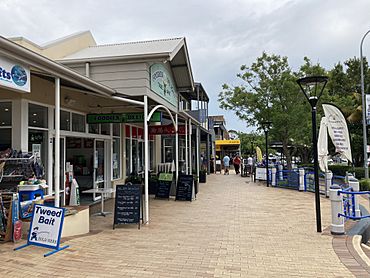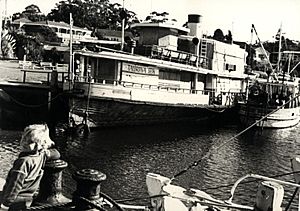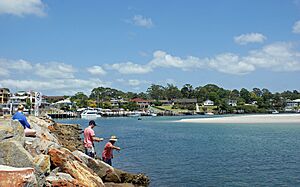Huskisson, New South Wales facts for kids
Quick facts for kids HuskissonNew South Wales |
|||||||||||||||
|---|---|---|---|---|---|---|---|---|---|---|---|---|---|---|---|

Shopfronts along Owen Street
|
|||||||||||||||
| Population | 786 (2016 census) | ||||||||||||||
| Postcode(s) | 2540 | ||||||||||||||
| Elevation | 14 m (46 ft) | ||||||||||||||
| Location | |||||||||||||||
| LGA(s) | City of Shoalhaven | ||||||||||||||
| Region | South Coast | ||||||||||||||
| County | St Vincent | ||||||||||||||
| Parish | Currambene | ||||||||||||||
| State electorate(s) | South Coast | ||||||||||||||
| Federal Division(s) | Gilmore | ||||||||||||||
|
|||||||||||||||
Huskisson is a lovely village in New South Wales, Australia. It sits right on the beautiful shores of Jervis Bay, which is part of the City of Shoalhaven. This charming spot is about 24 kilometers (14 miles) south-east of Nowra.
Contents
What's in a Name?
Huskisson was named by Governor Sir George Gipps. He chose the name to honor a British politician named William Huskisson.
Exploring Huskisson's Geography
Huskisson is located next to Currambene Creek. This creek is a great spot for boats to anchor and for fishing. The village is a popular tourist destination because of its amazing white sand beaches and clear, emerald-colored waters. While all the beaches are beautiful, Hyams Beach to the south is especially famous for having some of the whitest sand in the world!
The town has natural borders: Currambene Creek to the north and Moona Moona Creek to the south. To the east, you'll find the stunning Jervis Bay shoreline and its beaches. To the west, the village is bordered by the Jervis Bay National Park.
Huskisson's Past: A Journey Through Time
Aboriginal History of Huskisson
The original people of the land around Huskisson are the Yuin people. They are the traditional owners of this area. For a long time, even into the 1900s, members of what was known as 'the Jervis Bay tribe' lived along the banks of Currambene Creek. These people are also known as the Wandandian people. They spoke a language called Dharamba, which was likely a northern dialect of the Dhurga language. Huskisson is very close to where the Dharamba dialect met the Thurawal language, and it's near the southern part of the Thurawal people's traditional lands.
How Huskisson Began
Huskisson started to form in the early 1840s. South of Moona Moona Creek, where Vincentia is today, there was a settlement called South Huskisson. This town was founded in 1841 as a seaport and the end point of The Wool Road. South Huskisson was a 'private town', meaning it was built on land owned by an individual, Edward Deas Thomson.
The land north of Moona Moona Creek was set aside by the government. The plan was for this area to become a 'government township' called Huskisson. Land was sold in both South Huskisson (in 1841) and the new Huskisson (in February 1843).
However, South Huskisson didn't do well and was quickly declining by 1850. Because of this, the 'government township' of Huskisson also struggled to grow. By the mid-1850s, land in both towns was almost worthless.
Huskisson only really began to develop when shipbuilding started there in the early 1860s. In its early days, Huskisson was often called 'North Huskisson'. It went back to being just 'Huskisson' once the old, privately-owned southern town (which people called 'the Old Township') had mostly disappeared.
Building Boats: Huskisson's Shipbuilding Story

From 1864 to 1977, Huskisson was a busy place for building ships. At least 131 large wooden ships were built here, along Currumbene Creek. This number doesn't even include all the smaller boats, barges, and timber carriers that were also made.
The shipyards built many different kinds of boats, including sailing ships, steamships, and schooners. They even built ships for trading between islands for a company called W. R. Carpenter & Co in the 1930s and 1940s. Two passenger ferries for Sydney, the Lady Denman (built in 1911) and the Lady Scott (built in 1914), were also built here.
Until the late 1940s, ships were built using an old method where the curved parts of the ship's frame came from naturally bent tree branches. Until 1940, Huskisson didn't even have electricity! This meant all the ships were built without power tools, except for a steam-powered saw to cut planks. The timber used came from local trees, usually just a few miles from the town.
During the Second World War, the Huskisson shipyard built four wooden ships for the American Army. These ships were used in the New Guinea campaign. After the war, new building methods arrived. In later years, most of the ships built were wooden fishing trawlers.
The main families who owned the shipyards were the Dent family in the early years, and later the Setree family.
Services and Facilities for the Community
In the early days, a post office operated in 'Huskisson' from January 1843 to December 1855. A new post office opened in 'North Huskisson' in November 1875. Its first postmaster was Andrew Mackenzie. By 1875, the 'North Huskisson' school was also open. A telephone exchange started in November 1912, and in 1940, the town finally got electricity.
There was also a 'Government Wharf' that was used by the Illawarra Steam Navigation Company for shipping.
Huskisson: A Growing Tourist Spot
By the 1890s, Huskisson started to become a popular place for holidays. The Dent family, who were also shipbuilders, opened the Jervis Bay Hotel in 1893. They also ran guesthouses right on the beachfront, welcoming visitors to enjoy the beautiful bay.
Who Lives in Huskisson?
According to the 2016 census, there were 786 people living in Huskisson. Most people (74.3%) were born in Australia, and 87.9% spoke only English at home. When it came to religion, the most common answers were No Religion (34.0%), Anglican (24.7%), and Catholic (17.7%).
Special Places: Heritage Listings
Huskisson has a few places that are protected because of their historical importance. One of these is:
- Dent Street: MV Lady Denman
Famous Faces from Huskisson
- John Storey: He was born in Huskisson and later became the Premier of New South Wales, a very important political leader.
- Adam Federici: A talented goalkeeper who played for the Olyroos, Australia's Olympic soccer team.
- Paul Greene: A musician and an athlete.



